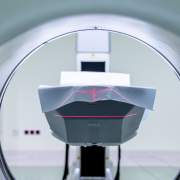Not all that glitters is gold: MR-DWI negative ischemic stroke

Author: Giuseppe Reale, MD, Catholic University of the Sacred Heart, Department of Neurosciences, Institute of Neurology. University Hospital “Fondazione Policlinico Gemelli”- Rome, Italy
In the last decade, the use of Magnetic Resonance (MR) in stroke clinical practice has grown significantly1,2. One of the most important MR sequences in ischemic stroke neuroradiological diagnosis is the so-called Diffusion-Weighted Imaging (DWI), that detects the cytotoxic edema, namely the swelling that occurs in cells during stroke3.
In daily clinical practice, a positive MR-DWI sequence among patients with suspected stroke and no evident changes on initial head CT is considered a confirmation of the clinical diagnosis.
However, there is growing evidence this may be more complicated. A recent meta-analysis of 3236 patients from 12 studies, found that 6.8% of acute ischemic stroke patients, had no DWI-findings, especially among patients with a “posterior circulation” stroke6.
Moreover, patients with a clinical diagnosis of ischemic stroke but a negative MR-DWI have in terms of disability, at the 1-year follow-up, the same outcomes as positive MR-DWI stroke patients and therefore they should receive the same secondary prevention7.
Put all this together, the reason why a significant percentage of symptomatic stroke patients have normal DWI sequences remains unclear. On one hand, the reduction of the blood flow required to cause neurological symptoms could be less severe than the reduction required to cause cellular swelling and, therefore, a positive DWI signal. Another possibility is that the cellular swelling could last for a time so short that it cannot be detected by the following MR imaging.7 Keeping this in mind, patients with stroke symptoms and negative DWI, also have a longer time from symptoms onset to brain MR scan8. Moreover, a few cases of DWI-positive ischemic lesions disappear after intravenous thrombolysis9.
In conclusion, stroke remains a clinical diagnosis, although MR-DWI continues to constitute a reliable and useful tool in acute ischemic stroke management. However, clinicians should be aware that DWI could be sometimes misleading: not all strokes glitter in DWI-sequences.
References
- Vilela P, Rowley HA. Brain ischemia: CT and MRI techniques in acute ischemic stroke. Eur J Radiol. 2017; 96:162-172.
- Burke JF, Kerber KA, Iwashyna TJ, Morgenstern LB. Wide variation and rising utilization of stroke magnetic resonance imaging: data from 11 states. Ann Neurol. 2012; 71:179–185.
- von Kummer R, Dzialowski I. Imaging of cerebral ischemic edema and neuronal death. Neuroradiology. 2017; 59:545-553].
- Fiebach JB, Schellinger PD, Jansen O, et al. CT and diffusion-weighted MR imaging in randomized order: diffusion-weighted imaging results in higher accuracy and lower interrater variability in the diagnosis of hyper- acute ischemic stroke. Stroke. 2002; 33:2206–2210.
- Schellinger PD, Bryan RN, Caplan LR, et al; Therapeutics and Technology Assessment Subcommittee of the American Academy of Neurology. Evidence-based guideline: the role of diffusion and perfusion MRI for the diagnosis of acute ischemic stroke: report of the Therapeutics and Technology Assessment Subcommittee of the American Academy of Neurology. Neurology. 2010; 75:177–185.
- Edlow BL, Hurwitz S, Edlow JA. Diagnosis of DWI-negative acute ischemic stroke: A meta-analysis. Neurology. 2017 18; 89: 256-262.
- Makin SD, Doubal FN, Dennis MS, Wardlaw JM. Clinically confirmed stroke with negative diffusion-weighted imaging magnetic resonance imaging: longitudinal study of clinical outcomes, stroke recurrence, and systematic review. Stroke. 2015; 46:3142-8.
- Simonsen CZ, Madsen MH, Schmitz ML, Mikkelsen IK, Fisher M, Andersen G. Sensitivity of diffusion- and perfusion-weighted imaging for diagnosing acute ischemic stroke is 97.5%. Stroke. 2015; 46:98-101.
- Caliandro P, Reale G, Tartaglione T, Rossini PM. The challenge of basilar artery occlusion wake-up stroke: too late for intravenous thrombolysis? Neurol Sci. 2016; 37:1137-40.



